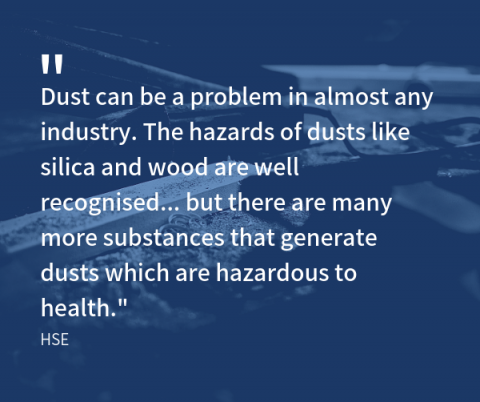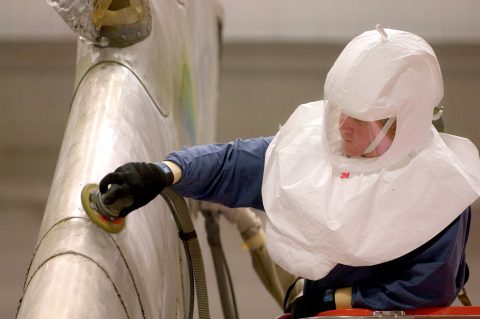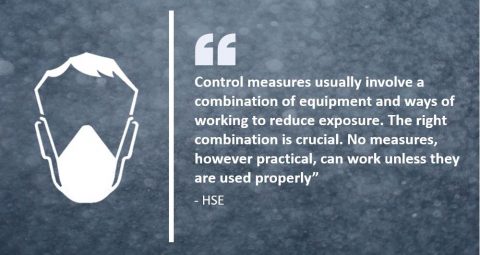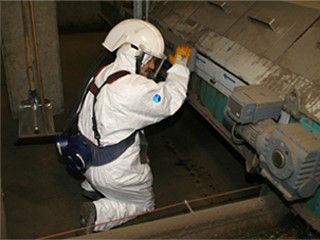WA Management strives to provide a professional service for your health and safety needs, while also endeavouring to create a greater awareness towards risks and hazards in the workplace. In this blog, WA Management continues its monthly documentation of workplace hazards, seeking to shed light on important and topical health and safety issues. For this month, we delve into the risks posed by dust and how businesses can safely mitigate the dangers faced by workers.
What is Dust and What are the Risks?
 Dust refers to small particles that are light enough to travel through the air. Because these particles can cause a significant damage to one’s health, dust is thus classified as a hazardous airborne substance. The reason for being classified as such is due to its short- and long-term effects, which can range from a difficulty breathing to life-threatening cancers. A profound example includes exposure to asbestos fibres, fibres which are so dangerous that they are covered by their own regulations separate to COSHH regulations more widely known throughout the workplace. The statistics prove why, with the HSE reporting 2,595 deaths in the UK in 2016 were as a result of mesothelioma, a cancer most prominently caused by over-exposure to such fibres.
Dust refers to small particles that are light enough to travel through the air. Because these particles can cause a significant damage to one’s health, dust is thus classified as a hazardous airborne substance. The reason for being classified as such is due to its short- and long-term effects, which can range from a difficulty breathing to life-threatening cancers. A profound example includes exposure to asbestos fibres, fibres which are so dangerous that they are covered by their own regulations separate to COSHH regulations more widely known throughout the workplace. The statistics prove why, with the HSE reporting 2,595 deaths in the UK in 2016 were as a result of mesothelioma, a cancer most prominently caused by over-exposure to such fibres.
In What Ways Does Dust Harm an Individual?
 The most commonly known type of harm is through inhalation. Inhaled dust can harm individuals in one of 2 forms:
The most commonly known type of harm is through inhalation. Inhaled dust can harm individuals in one of 2 forms:
Total Inhalable Dust – These particles are large and can become lodged in the nose, mouth, throat or upper respiratory system where they can damage airways.
Respirable Dust – These particles are even smaller and can be breathed into the lungs, resulting in lung damage further on.
While many will immediately think of the effects that dust inhalation may pose, what is much overlooked however is the effect of dust on the eyes and skin.
The human eye is one of the most fragile organs within the human body and exposure to dust can thus pose significant consequences, including permanent blindness. Our vision is also responsible for over 80% of our perception of the environment we are situated in and it is therefore paramount that appropriate measures are in place to mitigate such consequences.
With skin, some dusts are highly irritable and can cause varying levels of damage to any exposed part of the body. One prominent example is cement dust, which carries the ability to dry the skin and cause severe dermatitis. Our hands are our common method of interacting with other people and objects. As such, any damage to the skin can hamper one’s ability to safely carry out daily tasks.
How Can the Risks of Dust be Mitigated?
 In cases where dust is unavoidable, there are two main options that are available: water and on tool extraction (OTE)
In cases where dust is unavoidable, there are two main options that are available: water and on tool extraction (OTE)
Water damps down dust particles, impeding their ability to become airborne. In order to effectively manage dust with this method, a constant and adequate quantity of water must be supplied to capture all newly exposed dust particles. Simply wetting the material before carrying out work is insufficient.
OTE on the other hand captures and removes any exposed dust particles before they spread to the wider working environment. OTE consists of four parts:
- The tool
- The capturing hood
- The extraction unit
- The tubing
The extraction units are designed to specific specifications (Low Class, Medium Class and High-Class) and a sufficient specification must be used for the type of dust that the work involves.
Personal Protective Equipment (PPE) and Respiratory Protective Equipment (RPE)
 Even with the use of Water and OTE, it cannot be guaranteed that the work involved will become dust-free. In order to ensure proper and safe mitigation of hazardous airborne substances, PPE and RPE should be used as a means of additional protection.
Even with the use of Water and OTE, it cannot be guaranteed that the work involved will become dust-free. In order to ensure proper and safe mitigation of hazardous airborne substances, PPE and RPE should be used as a means of additional protection.
With PPE, the eyes must be protected with safety goggles which form a seal around the wearer’s eyes. Employees must also wear protection for their skin, such as gloves, which provide an adequate level of chemical resistance against corrosive dusts before permeating and degrading.
RPE is considered a subcategory of PPE and there are also multiple types to choose from. Each type of RPE has an Assigned Protection Factor (APF) which determines the level of protection the RPE can provide. Some types of RPE, such as full-face masks, also incorporate full eye protection, identical to sealed safety goggles.
The HSE states that any PPE and RPE used must be adequate and suitable for the work that is to be undertaken. As such, the mask must also be appropriate for the wearer, task and environment, without creating additional risks or work difficulties.
Conclusions
Staying safe when it comes to dust can be difficult, but here at WA Management, our professional consultants are here to help, providing advice on which PPE and RPE to use for your tasks. Our clear and concise COSHH reports can also help amalgamate all this important information into quick and easy to read documents.
If you are looking for such information, then why not get in touch with us? Call us on 01926 883 600 or write to us HERE and we’ll be more than happy to create a tailored solution for your needs.
